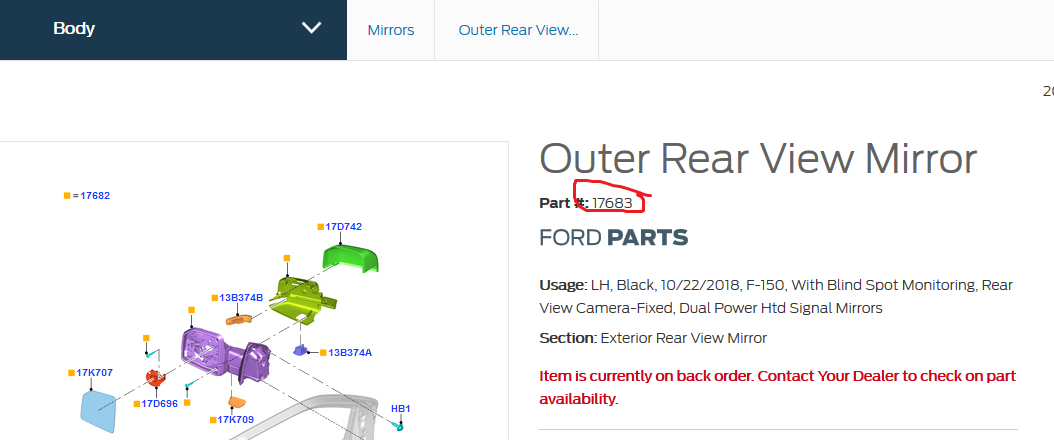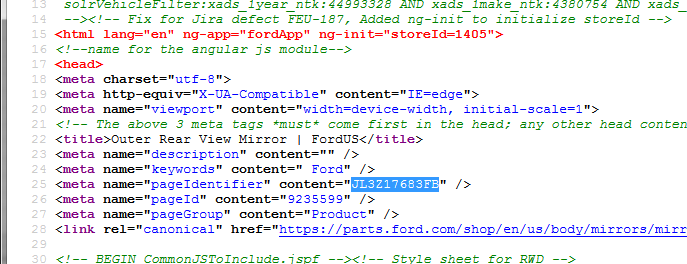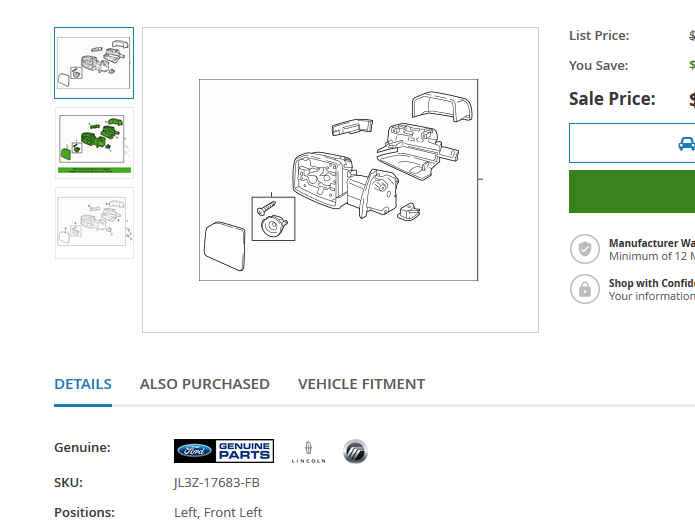 "RamblinRover Luxury-Yacht" (ramblininexile)
"RamblinRover Luxury-Yacht" (ramblininexile)
05/29/2020 at 14:25 • Filed to: wobsats
 6
6
 19
19
 "RamblinRover Luxury-Yacht" (ramblininexile)
"RamblinRover Luxury-Yacht" (ramblininexile)
05/29/2020 at 14:25 • Filed to: wobsats |  6 6
|  19 19 |
Funny story. Ford’s website doesn’t list the internal p/n for a part, merely the “within catalog” part number, when you go to look something up by VIN. However, the source code has the real number.

vs.

“17683" is just a number that Ford uses to mean “driver’s mirror”, and only has relevance within a model’s page... but the truth is out there.
 Who is the Leader - 404 / Blog No Longer Available
> RamblinRover Luxury-Yacht
Who is the Leader - 404 / Blog No Longer Available
> RamblinRover Luxury-Yacht
05/29/2020 at 14:31 |
|
2 5 f12 for the win
So the
y manufacture the replacement parts, but make it difficult to
buy them?
Makes sense. I love doing shit like this. Well, if you proceed to go and buy them from Ford, their system will get the number right. I think the theory is to make it fucky to buy aftermarket replacements. Although: in this particular case, no aftermarket version exists *and* Ford’s own main website doesn’t carry the part in inventory at the local dealer I selected, so... Apparently one has to hack, search the number, and view it at various suppliers of OEM Ford parts, many of which not named car-id are actually using Ford’s own inventory management system for it themselves... ...but a different version, which includes the SKU. Madness.
I had not thought to try mining the source code until I searched for a similar p/n which did have an aftermarket version, and Ford’s part website popped up with the p/n indexed in the source code
. Which, when opened, then helpfully told me “that doesn’t fit” based on the cookie for the vehicle I was searching
. Herp derp.
I try to tell my dad that finding parts really isn’t this hard, but sometimes it really is this hard.
This is good oppo By tweaking the code within Chrome, you can temporarily remove many of the paywall strategies and access the content. Any tweaks you make remain valid for that session, but there are some chrome extensions which will apply the tweaks every time you visit the site. You could easily add a line that shows the valid part number while browsing through the catalog. here’s how Ford part #s work. they’re formatted prefix-base-suffix, telling you (in order) when/where it’s used, what it is, and which one it is. the “base” tells you what the thing is; you are correct in that “-17683-” represents a LH side view mirror. So every LH side view mirror for every vehicle line will have the same part # base. the “prefix” tells you when the part was released, which vehicle line it launched on, and what organization released it. so in that case, JL3Z- means: “J” 2018 Model Year (this character is aligned to the MY character in the VIN) “L3" = F-150 “Z” = Parts and service. the “suffix” tells you what variant the part is. in that case, “-FB” means “F” is the mirror assy with BLIS, camera, power and heat, and “B” probably means it has the black skullcap. Service part prefixes always end in “Z” because service parts may come as assemblies or subcomponents which are different from the way they’re shipped to the plant. The box you buy them in will have the service part #, but the part itself will have the engineering part # on it. It’s almost the same, but the prefix will be different. I think the engineering part # for that would be something like “JL3B-17683-FBB” or the like; the suffix gets an additional character for color parts. if the same part gets used on a different vehicle (say that mirror gets used as-is on the Super Duty pickup) then it keeps its original part number. I wasn’t sure it would snag you, but I figured this thread counted as Jimbait regardless whether the Jims were biting.
Given that I know Ford parts going back to the ‘60s use a three-part system with model-related prefix, I assume what we’ve got now is really just a continuation of that (for example,C3AZ prefix for a lot of Galaxie, Falcon, and Mustang
stuff or whatnot).
The scary thing, is that someone had to deliberately
make it this way. Which is kinda gross, but also not surprising.
the format is the same, but the issuing scheme changed sometime in the late ‘90s or early 2000s. way back in the day I think the first character was “decade,” then I’m not sure about the rest. stuff changes too rapidly nowadays for that scheme to hold. plus there are a lot more groups releasing parts that didn’t exist in the ‘60s.
There’s a partial
sort-of-
innocent explanation in JimZ’s reply, in that, well, that *is* the part number in a sense as long as you’re looking at only the specific model of vehicle
, and the number is a specific descriptor of the assembly involved without being “untidy”.
The only “
suspect” thing is that despite putting the part index into the page, it’s not consumer-side visible *at that point*, which seems like somebody said “do we put the full p/n on the page... NAH!” -
very possibly to discourage cross-shopping as I suggested.
Bwahahaha. God, I hate Ford’s parts website and the way they display information.
I figured it was worth a post, as it was (a) useful, (b) amusing, and (c) perverse.
I’ve grown to really like Ford’s part number system.
There have
been times when I had trouble locating
a part, and I was able to find it by reconstructing a part number using
the base #
from one car and the prefix from the car I needed it to be for.
It was. Bravo. that doesn’t always work, though, depending on the part. if it’s something vehicle specific (trim, lighting, etc.) yeah, but commodity parts are another thing. if a vehicle line picks up a part that already exists, the part number doesn’t change. To stick with RamblinRover’s example, if the Super Duty uses the exact same mirror assembly from the same supplier (and it could, given the cab is the same as F-150) then the p/n for the F-250 mirror would still be“JL3Z-17683-xx” and not “JC3Z-17683-xx.” another potential confuser is superseded parts. if there’s a minor design change or fix done and released on the next model year, and the part is backwards compatible then even if you have a 2018 (“J”) vehicle you might be getting the newer part (which would be “KL3Z-17683-xx.”) the last is when the service p/n base is different from the engineering p/n base. which does happen. GM parts numbering system is way better.
 CalzoneGolem
> RamblinRover Luxury-Yacht
CalzoneGolem
> RamblinRover Luxury-Yacht
05/29/2020 at 14:33
 0
0
 WasGTIthenGTOthenNOVAnowbacktoGTI
> RamblinRover Luxury-Yacht
WasGTIthenGTOthenNOVAnowbacktoGTI
> RamblinRover Luxury-Yacht
05/29/2020 at 14:34
 1
1
 and 100 more
> RamblinRover Luxury-Yacht
and 100 more
> RamblinRover Luxury-Yacht
05/29/2020 at 14:35
 2
2
 RamblinRover Luxury-Yacht
> WasGTIthenGTOthenNOVAnowbacktoGTI
RamblinRover Luxury-Yacht
> WasGTIthenGTOthenNOVAnowbacktoGTI
05/29/2020 at 14:44
 2
2

 RamblinRover Luxury-Yacht
> and 100 more
RamblinRover Luxury-Yacht
> and 100 more
05/29/2020 at 14:45
 3
3
 Akio Ohtori - RIP Oppo
> RamblinRover Luxury-Yacht
Akio Ohtori - RIP Oppo
> RamblinRover Luxury-Yacht
05/29/2020 at 15:01
 0
0
 TheRealBicycleBuck
> RamblinRover Luxury-Yacht
TheRealBicycleBuck
> RamblinRover Luxury-Yacht
05/29/2020 at 15:04
 0
0
 jimz
> RamblinRover Luxury-Yacht
jimz
> RamblinRover Luxury-Yacht
05/29/2020 at 15:14
 3
3
 RamblinRover Luxury-Yacht
> jimz
RamblinRover Luxury-Yacht
> jimz
05/29/2020 at 15:23
 0
0
 WasGTIthenGTOthenNOVAnowbacktoGTI
> RamblinRover Luxury-Yacht
WasGTIthenGTOthenNOVAnowbacktoGTI
> RamblinRover Luxury-Yacht
05/29/2020 at 15:29
 0
0
 jimz
> RamblinRover Luxury-Yacht
jimz
> RamblinRover Luxury-Yacht
05/29/2020 at 15:34
 0
0
 RamblinRover Luxury-Yacht
> WasGTIthenGTOthenNOVAnowbacktoGTI
RamblinRover Luxury-Yacht
> WasGTIthenGTOthenNOVAnowbacktoGTI
05/29/2020 at 15:38
 1
1
 NKato
> RamblinRover Luxury-Yacht
NKato
> RamblinRover Luxury-Yacht
05/29/2020 at 15:43
 0
0
 RamblinRover Luxury-Yacht
> NKato
RamblinRover Luxury-Yacht
> NKato
05/29/2020 at 16:02
 0
0
 Urambo Tauro
> jimz
Urambo Tauro
> jimz
05/29/2020 at 17:58
 0
0
 NKato
> RamblinRover Luxury-Yacht
NKato
> RamblinRover Luxury-Yacht
05/29/2020 at 18:10
 0
0
 jimz
> Urambo Tauro
jimz
> Urambo Tauro
05/29/2020 at 19:20
 1
1
 pip bip - choose Corrour
> RamblinRover Luxury-Yacht
pip bip - choose Corrour
> RamblinRover Luxury-Yacht
05/29/2020 at 20:45
 0
0